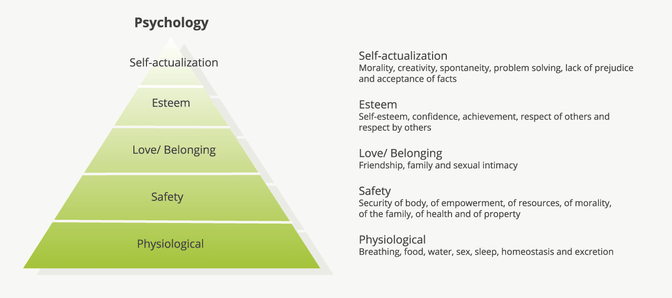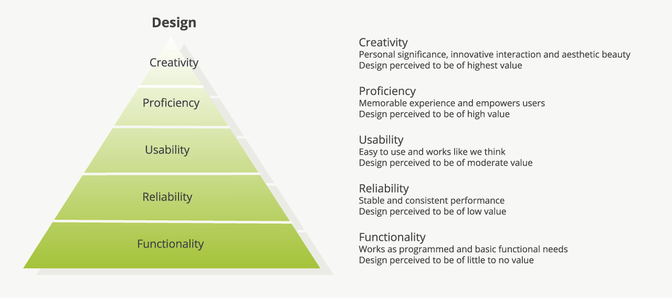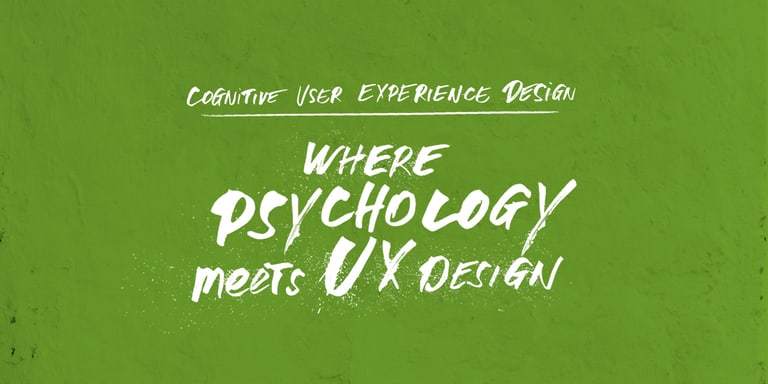Based on my last blog post Cognitive User Experience Design - Where Psychology meets UX Design I will focus now on Motivation and describe which role the Hierarchy of Needs plays in design. This raises the following question.
What is the Hierarchy of Needs about?
The most prominent contribution in psychology is the Hierarchy of Needs of Abraham Maslow. The psychologist describes that the human motivation consists of five distinct groups of needs, namely Physiological, Safety, Love/ Belonging, Esteem and Self-actualization. The basic level of needs are at the bottom of the hierarchy and must be ensured first before focusing on higher level needs.

As soon as the Physiological needs (with breathing, food, water, sex, homeostasis and excretion) are fulfilled, the next higher need Safety (with security of body, of empowerment, of resources, of morality, of the family, of health and of property) should be focused. The Safety level is followed by Love/ Belonging and characterized by friendship, family and sexual intimacy. Achieving this level of needs is already good and the chasm to the next two needs is often difficult to cross. The level of Esteem needs (with its self-esteem, confidence, achievement, respect of others as well as respect by others) defines the fourth level of the hierarchy. On top of the Hierarchy of Needs is the Self-actualization where morality, creativity, problem solving lack of prejudice and acceptance of facts are in the focus.
Maslow argued that if the needs of a prior level are not met, the hierarchy won’t be stable and leads to feelings of stress and anxiety. For example, a good performance in a team at the job (need 3) is not possible when you are starving and your hunger is overwhelming (need 1). That’s why we seek to stabilize the lower-level needs before trying to focus on higher-level needs.
What are the critical comments about the Hierarchy of Needs?
Despite this intuitive perspective, only little evidence for the hierarchical order is given. For instance, in some cultures the social need is the first and most important need. Another interesting extension point of Maslow’s theory is that selfless acts, bravery, charity or the spiritual beliefs should be taken into account too.
Another approach is Maslow’s own expansion of his Hierarchy of Needs in 1970. Accordingly, the Esteem need is followed by Cognitive need, which consists of knowledge and understanding, curiosity, exploration, need for meaning as well as predictability. The next need is Aesthetic where beauty, balance and form are appreciated. Followed by Self-Actualization, which was already part of the first version of Maslow’s Hierarchy of Needs, the top need is Transcendence. This need is characterized by encouraging others in achieving Self-actualization.
How can we apply this psychological knowledge to UX Design?
Applying this knowledge to UX Design, the hierarchy levels are Functionality, Reliability and Usability, followed by Proficiency and on top Creativity.

The bottom of Bradley’s Design Hierarchy of Needs corresponds with the Functionality and consists of working as programmed and meet basic functionalities. Functional designs are perceived to be of little value for design. For example, a website loads within a reasonable time. The Functionality needs are followed by the Reliability which is defined by stable and consistent performance. Reliable designs are perceived to be of low value of design. Accordingly, a website that worked one week before should work today too, even when new sections have been deleted or added. The third level Usability is ensured as soon as the design is easy to use and works like we think. Usability design is perceived to be of moderate value, which means that some basic expectations work. For example, a website is easy understandable and has a navigation that works. Proficiency and Creativity form the top of the UX Design Hierarchy of Needs. Thereby, Proficiency contains memorable experience, empowers users and meets a high level of design. It provides suggestions that refer to favorites or advanced search entries. Proficiency is followed by Creativity, which is characterized by personal significance, innovative interaction and aesthetic beauty. A creative design is perceived to be the highest level because it satisfies users and leads to loyal users.
What are the critical comments about the Design Hierarchy of Needs?
Similar as for Maslow’s pyramid, the Design Hierarchy of Needs makes intuitively sense. Nevertheless, the hierarchic order must not be followed strictly. The user might like an aesthetically beautiful website more that doesn’t work reliable than a boring but reliable one. It should, however, be noted, that when a website that doesn’t load, the website itself fails. Therefore, to use the design hierarchy as a guideline to first fulfill needs of the lower-level before focusing on higher-levels is recommended.
As mentioned before, a UX designer needs to consider the different levels of needs and should strive for proficiency and creativity in order to surprise users with delightful services with a great user experience.
Because the topic Motivation is so comprehensive and has such an intensive impact on design I will take you on a short journey in my next blog post and characterize what kind of impact Flow has on design.

